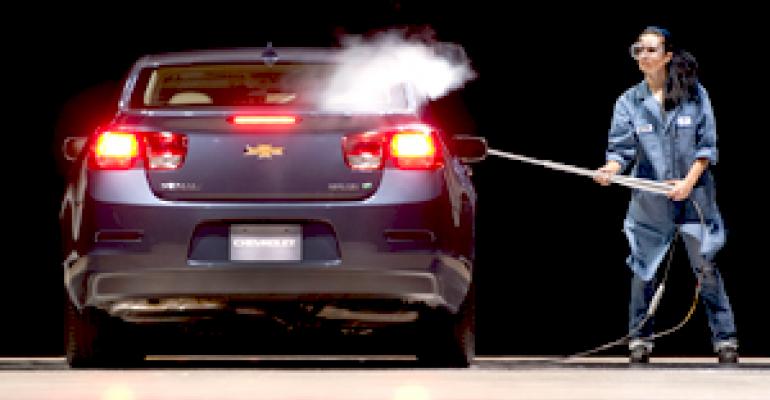
WARREN, MI – General Motors researchers are on the brink of multiple breakthroughs in aerodynamics that promise to make its cars and trucks more fuel efficient, says John Cafaro, chief exterior designer of the new Chevrolet Malibu that’s due early next year.
“It’s scary, some of the numbers we are dabbling with,” he tells WardsAuto during an event at the auto maker’s research and development unit here to highlight the slipperiness of the redesigned-for-’13 Chevrolet Malibu.

The car is being tested in GM’s wind tunnel, which the auto maker says is the largest closed-loop facility in the industry.
Based on pre-production models, the next Malibu will post a drag coefficient value of 0.29. That’s comparable with the sleek Chevy Corvette sports car and on par with the Chevy Volt extended-range electric vehicle at 0.28. The previous-generation Malibu registered 0.35.
The new numbers will help Malibu achieve upwards of 38 mpg (6.2 L/100 km) using mild-hybrid technology, according to GM. The most fuel-efficient Malibu on sale now achieves up to 33 mpg (7.1 L/100 km).
Every extra mile counts these days, as high pump prices have consumers paying closer attention to fuel-economy numbers and regulators looking to trim tailpipe emissions.
Auto makers also face strict new corporate average fuel economy rules in coming years, reaching 35.5 mpg (6.6 L/100 km) in 2016 and a recently proposed 54.5 mpg (4.3 L/100 km) by 2025.
Cafaro says GM researchers soon will render the new Malibu’s aerodynamic numbers as antiquated by taking the fight against drag underneath the vehicle.
“We’re just starting to get our arms around the top of the car,” he says. “The bottom of the car is uncharted territory.”
The Malibu uses a number of increasingly common approaches to fight drag, such as active shutters in the lower grille of the front fascia that open and close automatically.
“That’s stuff that wasn’t even on the shelf a few years ago,” Cafaro says.
Rounded headlamps help move air smoothly across the Malibu’s side panels, and deflectors forward of the front tires act as air dams. Specially designed side mirrors deflect wind without upsetting air flow, GM says, and a raised deck lid helps move wind off the car more efficiently.
Cafaro says side-vision cameras appearing on concept cars could eliminate the need for side mirrors, although today’s federal regulations require them.
He admits the Malibu’s rear deck brings to mind the controversial BMW 7-Series critics derided during the last decade but validates the styling as a useful aerodynamic tool. “It’s become a popular styling cue today and improves fuel economy,” Cafaro says.
However, manufacturing a smooth floor panel for the underbody remains a difficult task, he says, citing a myriad of cabin and exhaust cooling parts and powertrain and chassis pieces that must be integrated.
“But the mandate is to push harder,” Cafaro says. Global design chief Ed Welburn, Chairman and CEO Dan Akerson and global product-development leader Mary Barra “want to be jarred” by creativity.
“They don’t want us to become complacent. Their hunger for new designs is limitless,” he says.
Cafaro points to the new BMW i3 and i8 electric cars launching in 2013 as an example of an auto maker pressing its employees for breakthroughs. “We’ve got a ways to go to catch up,” he says.
The new Malibu will arrive early next year from GM’s Fairfax, KS, assembly plant, with a model featuring mild-hybrid technology leading the launch. Pricing has not been announced.




